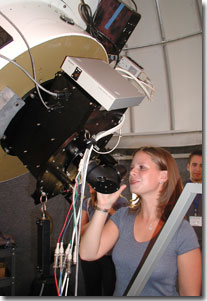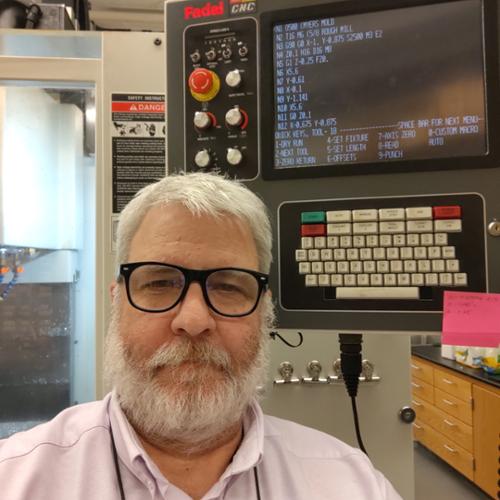Observatory
Telescope and TCS
Few pieces of modern scientific equipment have the majesty of an astronomical telescope. The gleaming white, yellow and black DFM Cassegrain telescope housed in Emory's new observatory is no exception. Located within the silver dome atop the Mathematics and Science Center, it is the centerpiece of the physics department's new astronomy program and one of the major attractions on campus.
Like all modern telescopes, this Cassegrain is fully controlled by a computer system and custom software. The Telescope Control System (TCS) is located in a separate room built directly beneath the observatory where astronomers can work comfortably in spite of the extreme summer and winter temperatures often found in the dome. Most of the actual work goes on in the control room where a thick batch of cables travels downward from the telescope to the TCS. In addition, there is also a terminal inside the dome where astronomers work side-by-side with the Cassegrain.
This telescope's 24-inch mirror affords it the "light gathering" ability to see deeply into the universe. Those using it can either look through the eyepiece directly into the heavens, or they can attach a CCD camera and observe their chosen subject on a computer monitor. In this case, the camera's small but powerful chip makes a record of what is being observed. Data is collected as long as the shutter stays open; when it closes, the data is read out from the camera and collected by the computer.
Emory astronomers use the data in different ways including photometric measurements and spectroscopy. When they want to take a picture of the celestial object or objects in view, they determine the precise exposure time and open and close the shutter accordingly. Depending upon the brightness of the subject, an exposure (also called "integration time") can last from a few milliseconds to hours.
The TCS makes finding a specific heavenly body a simple matter of moving the mouse. Want to examine the Horsehead Nebula in the constellation Orion? Simply direct the cursor on the monitor to the displayed sky map, find the nebula, click, and stand by as the automated guidance systems moves the telescope and points it toward the target. At the same time, the opening in the dome moves in sync with the movements of the telescope.
Observation Pad
 The observatory also includes a spacious observation pad where mounts for 10 smaller telescopes await astronomy students throughout the year. It's a great place to survey the campus and enjoy an evening under the stars.
The observatory also includes a spacious observation pad where mounts for 10 smaller telescopes await astronomy students throughout the year. It's a great place to survey the campus and enjoy an evening under the stars.

